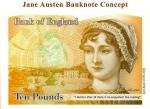Guest post by Janine Barchas
I realize that it is not attractive to kvetch about something good not being good enough, but I just cannot help myself.
A few days ago, the Bank of England confirmed the welcome news that Jane Austen will grace a new 10-pound note. Bank of England Governor, Mark Carney, announced how Jane Austen “merits a place in the select group of historical figures” that appear on British currency as “one of the greatest writers in English literature.” Great decision.
- BOE Governor Mark Carney with the new ten-pound note concept design. Photographer: Chris Ratcliffe/Bloomberg
- Full image of the new ten-pound note concept design.
Ten pounds is also a particularly meaningful denomination for Jane Austen. She sold her first literary manuscript, then called Susan, for £10 in 1803. Sadly, she never saw it published. After a decade of waiting while it languished in some publisher’s basement, her brother Henry, then a banker, kindly bought the manuscript back for the same sum of £10. Not until six months after Jane Austen’s death in 1817 was the book finally published, under the title Northanger Abbey.
In spite of this apt choice, and the banknote’s welcome recognition of Austen’s literary stature, the preliminary concept design for the new tenner is raising eyebrows among Austen fans. The reverse of the Jane Austen £10-note will include the following features, described here in the words of the Bank of England’s own press release:
- The quote – “I declare after all there is no enjoyment like reading!” from Pride and Prejudice (Miss Bingley, Chapter XI).
- Portrait of Jane Austen. Commissioned by James Edward Austen Leigh (Jane Austen’s nephew) in 1870, adapted from an original sketch of Jane Austen drawn by her sister, Cassandra Austen.
- The image of Godmersham Park. Godmersham was home of Edward Austen Knight, Jane Austen’s brother. Jane Austen visited the house often and it is believed that it was the inspiration for a number of her novels.
Part by part, the design seems an ill-advised rough draft:
1) The choice of quote is impervious to Austen’s characteristic irony. Caroline Bingley is an unsympathetic poseur, a non-reader who prefers cards to books. The Guardian has already called the choice “a major blunder” and has asked for a rethink of the quotation. Many cheeky alternatives readily present themselves, including “A large income is the best recipe for happiness I have ever heard of.” Uttered by the crass Mary Crawford in Mansfield Park, that line’s irony would at least cut with the grain of paper money rather than disingenuously against it.
2) The Bank of England’s choice of author portrait is a saccharine Victorian derivative of the original sketch by Cassandra Austen in the National Portrait Gallery. In 1870, her sycophantic nephew did not think this 1810 portrait of his “Dear Aunt Jane” pretty enough to front his family memoir and so commissioned an engraving that softened the author’s features. Why yet again the airbrushed Victorian byproduct and not the edgy original? No one at the B of E thought it necessary to prettify Winston Churchill, whose scowling portrait is to appear on a new fiver in 2016.
- Jane Austen by Cassandra Austen pencil and watercolour, circa 1810 NPG 3630 © National Portrait Gallery, London
- Jane Austen after Cassandra Austen stipple engraving, published 1870 NPG D1007 © National Portrait Gallery, London
3) The banknote shows off Austen’s brother Edward’s manor in Kent rather than her own humbler home in Chawton, Hampshire. Jane Austen’s House Museum, the cottage where the author lived from 1809 to 1817 and from which she launched her novels into the world, was chosen by the Bank of England as the picturesque setting for its ceremonious reveal of the banknote’s concept design. Yet this same Chawton cottage, which draws over 30,000 visitors a year, is not grand enough to be on the tenner?
Jane Austen fans do not want to look this proverbial gift horse in the mouth. We applaud the good sense shown by putting this author on a banknote. But many of us are hoping this design is just a first offer. Luckily, the Bank of England has allowed for a healthy amount of lead-time before the note’s planned release in 2017—plenty of time to tweak the drafted concept design.
As Austen wrote, “an artist cannot do anything slovenly.” What she meant was that they should not. This great idea deserves a better execution.
 Janine Barchas is a professor of English at the University of Texas at Austin and the creator of the online gallery What Jane Saw. Her widely praised Matters of Fact in Jane Austen: History, Location, and Celebrity is now available in paperback from Johns Hopkins University Press.
Janine Barchas is a professor of English at the University of Texas at Austin and the creator of the online gallery What Jane Saw. Her widely praised Matters of Fact in Jane Austen: History, Location, and Celebrity is now available in paperback from Johns Hopkins University Press.



